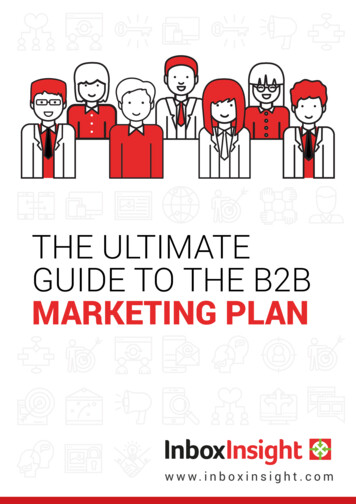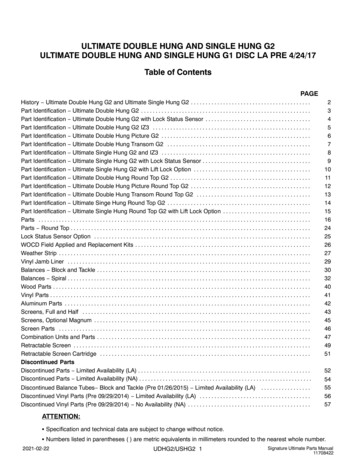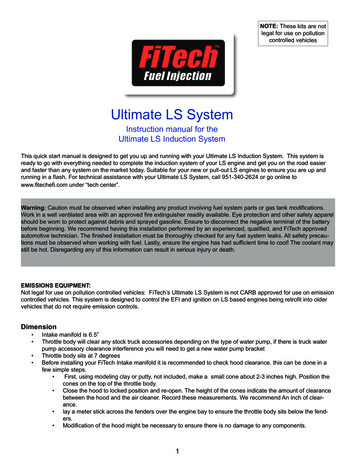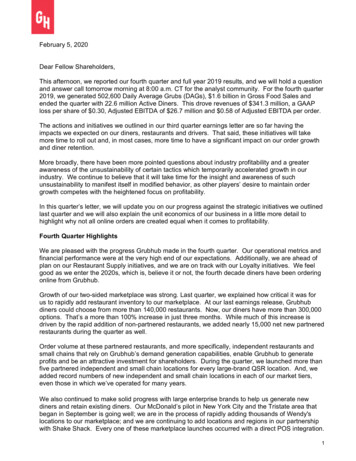
Transcription
THE ULTIMATEGUIDE TO THE B2BMARKETING PLAN
THE ULTIMATEGUIDE TO THE B2BMARKETING PLANTHE MARKETINGPLAN IS ONE OF THEMOST IMPORTANTOUTPUTS OF THEMARKETINGPROCESS.KOTLER & KELLER, 2008IT FORCES THE COMPANY TOSHARPEN ITS OBJECTIVES AND POLICIES,LEADS TO BETTER COORDINATION OFCOMPANY EFFORTS, AND PROVIDESCLEARER PERFORMANCESTANDARDS FOR CONTROL.KOTLER, ARMSTRONG, WONG AND SAUNDERS, 20082 ULTIMATE GUIDE TO THE B2B MARKETING PLANwww.inboxinsight.com
INTRODUCTION: WHY DOI NEED A MARKETING PLAN?Whilst it may take time initially tosystematically plot all the phasesof your plan into one organized effort,in the long run you will continuouslyreap the benefits, as you navigateyour competitive landscape withgreater ease and clarity.Failure to plan, as Benjamin Franklinonce said, is planning to fail. Whilemany people would rather be doingthan planning, marketing is at itsstrongest when it’s structured.WHY?Think of it as your blueprint, the masterdocument that aligns your marketingstrategy with your business goals whilstorchestrating your marketing objectivesinto a coordinated set of coherent activities.It does this by helping you understand: Where you are Where you want to beRemember, every business is different.This resource has been written as aguide to help you structure your planningprocess. Using PR Smith’s SOSTAC framework, each phase of the marketingplan has been broken up into easy-to-digestsections full of best practices,expert tips and actionable techniques.Many marketing professionals findthis framework useful – we hopeyou do too! H ow to get there (in the mostefficient and profitable way!) ULTIMATE GUIDE TO THE B2B MARKETING PLANwww.inboxinsight.com3
CONTENTS05 Part 1: Corporate Objectives; What’s your mission?06 Part 2: Situation; Where are you now?13 Part 3: Objectives; Where do you want to be heading?14 Part 4: Strategy; What’s your game plan?18 Part 5: Tactics; How EXACTLY will you get there?25 Part 6: Action Plan; Who does what and when?28 Part 7: Control; How do we measure success?4 ULTIMATE GUIDE TO THE B2B MARKETING PLANwww.inboxinsight.com
PART 1: CORPORATE OBJECTIVES;WHAT’S YOUR MISSION?HOW THE B2B MARKETING PLAN FITSINTO THE ORGANIZATIONAL FRAMEWORK:In advance of your marketing planning,key decisions and business goalsshould be discussed and agreed.CORPORATE MISSIONThis should take the form of a MissionStatement and overarching CorporateObjectives, as illustrated below:CORPORATE OBJECTIVESPHASE 1: GOAL SETTINGMISSIONMARKETING OBJECTIVESCORPORATE OBJECTIVESMARKETING PLANAs the marketing function, your role isto interpret these objectives as desiredfuture direction and translate theminto market-led objectives.What’s more, the nimbleness afforded bydigital marketing tools and real-time datacapture mechanisms, lends itself to creatinga strong test and learning environment thatdrives crucial insight back into the businessto bolster agility and strategic precision.These in turn form the basis of anactionable plan that considers yourcurrent situation and prescribes the mostattractive course of action, compatiblewith your core internal capabilities.For example, this may take the formof isolating a specific industry to target,designing a digital content strategy to drivebrand awareness and create cut throughwhilst closely monitoring response inorder to justify greater future investment.The diagram (opposite) shows howan organization’s planning existsin a hierarchy. If you’re operating inthe commercial sector, the businessobjectives are overarching andprofit orientated.The more you can align your marketingactivities to your overarching businessobjectives, the better you can demonstratehow the marketing effort is directlyaccountable for helping to achieve thecorporate mission. Researching and planning your marketingstrategy will help you understand how toachieve the above through reinforcing whatmakes your business unique, identifyingwhich customers to target and informing theright tactics to leverage.Once your corporate mission andobjectives are set, it’s time to kick offyour marketing planning process!ULTIMATE GUIDE TO THE B2B MARKETING PLANwww.inboxinsight.com5
PART 2: SITUATION;WHERE ARE YOU NOW?SITUATION: I dentifying new profitable opportunities(essential for business growth)Your mission statement andbusiness plan set the ultimate goalsfor your business, however, situationanalysis is required to identify themost profitable market segments,key competitors, your internalcapabilities and significantexternal/internal influencers. M itigating risk through identifyingexternal threats or influencers (suchas political, economic, legal.etc.)Underpinning your situationanalysis is accurate insight revealedby well-structured market research.Market Research OverviewResearch conducted by the marketingfunction is highly valuable because itprovides market intelligence specific toyour business. With the digital meansto capture real-time data and customerinsights, CMOs are in the unique positionto conduct and collate research that willhelp C-Suite decision makers make betterinformed decisions concerned with theprofitability, sustainability and longevityof the organization.The right market insight can facilitatebetter decision making andinvestment by: E nabling a deep understanding of targetcustomer segments (essential for datadriven targeting such as ABM strategies) P roviding visibility into your competitorlandscape (crucial in a fast-movingmarketplace)6One of the key focuses of the B2BMarketing Plan is to translate all thisknowledge into an actionable plan ofattack focused on gaining competitiveadvantage. But before you can evenconsider strategy you need to stand backand consider your current situation.Situation AnalysisMany marketers have an instinctiveidea of where their company sits in themarketplace, and over time businessesoften settle into their niche.But being comfortable doesn’t meanyou’re in the right place.With the digital boom creating a levelplaying field for businesses of all sizes,complacency is a killer. You don’t have tolook far to see how nimble new businessesand start-ups such as Uber and Airbnbhave disrupted the market, dismantling thesuccess of former power giants. Wouldthe latter have made the same decisionsif they had been able to better predictwhat was about to happen?Equipping your business with the rightmarket intelligence is your only defence in aperpetually shifting and highly competitivelandscape. This is oneof the many reasons why researchis key in your B2B Marketing Plan. ULTIMATE GUIDE TO THE B2B MARKETING PLANwww.inboxinsight.com
By giving you a bird’s eye of view of yourbusiness and the dynamic environmentit’s situated in, market research will helpyou identify who your key audiences areand how you can mitigate risk to gaincompetitive advantage.marketplace - understanding the contextyour organization operates in is crucial. It’simportant to be aware of all the differentfactors that influence your businessnow and in the future. This is especiallyimportant if you’re lookingat longer-term decision making.3 KEY AREAS TO CONDUCTYOUR RESEARCH:In order to do this, we recommend yourresearch should aim to identify asmany of the following as possible:1. Your Marketplace2. Your Competitor Landscape3. Unique Audience Insight M acro-Environmental Factors Micro-Environmental Stakeholders Key Internal FactorsThe Marketing AuditBefore you start formulating thedirection you think your business shouldbe heading, take a moment to define yourTo ensure your research remainsstructured, we recommend leveraging anaudit model. Here are some of just a fewcommonly used audits we recommendto kick-off your marketplace analysis:Key Factors & mentalStakeholdersKey InternalFactorsThese are externalinfluences the companydoesn’t have control overbut through identification,can respond and factorinto your marketingplan strategy, to removeany threats and useto advantage.Long term relationshipswith stakeholders areessential to a company’slongevity. Both internaland external, differentstakeholders havevarying influence overthe company.Auditing your company’sinternal resources iscrucial for identifying corecapabilities whilst flaggingup areas for improvement.Recommended audit:Recommended audit:Recommended audit:P.E.S.T.L.E. (Political,Economic, Social,Technological, Legal &Environmental factors)Mendelow’s MatrixThe 5M’s model(Manpower, Materials,Machinery, Minutes,Money)Identifying and prioritizingkey players helpsjustify where to allocateresources to nurture longterm value exchanges This ensures you havethe internal resourcesto achieve your mission.ULTIMATE GUIDE TO THE B2B MARKETING PLANwww.inboxinsight.com7
To ensure you maximize your researchfindings, it’s best practice to run a SWOT(Strengths, Weaknesses, Opportunities,Threats) analysis to collate all your auditfindings. This makes it easier to gain acomprehensive overview from whichto base strategic decisions.COMPETITOR ANALYSISThe sustainability, profitability andlongevity of your business relies onthe ability to deliver superior valueto your customers.Traditionally, this was relatively simple less choice, accessibility and transparencymade price a key differentiator ofperceived value and customer loyalty.In today’s multi-channel digital world,full of choice, information andcompetition, value is a lot morecomplex - we as marketers, have towork a lot harder to attract, engage andsustain the attention of our audiences.In response, innovative companies arerethinking the way their business modelcreates, delivers and captures value.This means, in order to stay relevant, youneed to keep a close eye on what thesebusinesses are up to. How are theytailoring their marketing mix to deliversuperior value? How are your targetaudiences responding to these newmarket entries?This is why competitor analysis is critical.Do a sweep of all your competitors, keepingtrack of all available services/products,features/benefits, pricing strategies,promotional channels etc. associatedwith your competitors. The more detailyou can capture the better.8Then, like you have for your own business,run a SWOT analysis for each of yourcompetitors. Draw on your researchfindings of them, how they presentthemselves and any press you can find.If you have contacts or customers inthe industry, ask them for their opinion.The more you can understand whoyou’re up against, the better you cantailor your strategy to achieve greatercompetitive advantage.As the competitive landscape isperpetually shifting with new challengersemerging with greater speed than everbefore, regular competitor analysisis critical.CUSTOMER ANALYSISWithout demand for your products orservices you have no business. That’swhy conducting research about yourcustomers, their needs, preferences andperceptions is vital. This is especiallycrucial if you are considering changingyour current market offering or if you arewishing to leverage targeting tacticssuch as account-based marketing(ABM) in your strategy.After all, the success of your marketingcampaigns rest on your ability to understandwhat your audiences want to hear.Primary Research:A good start is to dive into yourcustomer database: Who are your most profitable clients? What are their salient characteristics? W hat shared characteristics can beused to govern target audience segmentcriteria (TAL, ABM lists.etc.)? ULTIMATE GUIDE TO THE B2B MARKETING PLANwww.inboxinsight.com
Interrogating your customer database withthese types of questions helps you builda deep knowledge of your most profitablecustomer segments. This enables you toidentify who you should be focusing yourattention on and how to set the definingcriteria. This is also a great way to kick offyour ABM planning if that’s part of yourstrategic ambitions.Whilst analyzing your CRM is a greatstarting point for observing trends,collecting data from other departments(such as Finance and Sales) canalso greatly enhance your researchfindings.The following template providessome key considerations:Customer ResearchWork with Finance & Sales tounderstand what knowledge youcan gather around customersCustomer UnderstandingHow often do customers buy fromus on average?What is our average customerlifetime value?What is the average spend of ourcustomers?What level of contact do we havewith customers?What is our biggest cause of lostcustomers? ULTIMATE GUIDE TO THE B2B MARKETING PLANwww.inboxinsight.com9
Secondary Research:Some stages of your marketing planmay require outsourcing the expertise ofspecialist agencies, publications and industryassociations. It’s always worth consideringthe long-term benefits of using othercredible sources to obtain unique insightthat would otherwise be unattainable.The following research analysis is anexample of where secondary data is hugelybeneficial, especially if you’re looking tobuild a Target Account List (TAL) and arewanting to sense check the profitability ofthis audience. For example, you may haveidentified a list of target accounts thatcurrently represent profitable opportunities,however before you put all your eggs inone basket, it makes sense to check thelong-term profitability of this audiencesegment. This is where the followingresearch is recommended:Total Addressable Market andServiceable Available MarketOnce you have defined what sort ofbusinesses your target customers are, youcan start to work out the Total AddressableMarket (TAM) – the overall revenue that istheoretically possible if you had 100% ofthe market share. Government data, tradegroups and research companies can allprovide useful secondary data.Of course, it’s not likely you will achieve100% of the market. Consider whichportions of that market are going to bedifficult or impossible to capture: t hose dominated by establishedcompetitors those you don’t have the capacityto effectively serve those that don’t suit your strategyThis will leave you with the ServiceableAvailable Market (SAM).10Take a step back and look at this figurecritically. Is it enough to sustain yourbusiness long term? What if you onlyachieved 50% or 10% of the SAM? Is themarket going to grow or shrink? A sanitycheck at this point can help you identifyother options and prevent a lot of stresslater down the line.Building out your TargetAccount Lists (TALs)Up until now we have been looking atmethods for collating quantitative data thatcan be used to justify decisions aroundtargeting tactics. However, you cannot solelyrely on quantitative data for giving you all thecustomer insight you need to make the bestinformed marketing decisions.This is a fundamental oversight in an agewhere customer-obsessed strategiesand emotive engagement tactics aredominating the B2B marketing scene.Therefore, qualitative research is highlynecessary if you are to understand howyour audiences perceive and ‘experience’value. Uncovering this knowledge will paydividends when it comes to B2B contentmarketing by helping you understand howto craft content that will resonate mosteffectively with your target audiences.The better you can understand youraudiences and subsequently what makesthem tick, the better chance you have ofdelivering successful marketing campaignsthat drive profitable long-term relationships.Customer surveys and interviews area great method for collecting your ownprimary qualitative data. The belowtemplate uses open-ended questionsto gather information that will help youconstruct a customer-centric perspectiveof your business: ULTIMATE GUIDE TO THE B2B MARKETING PLANwww.inboxinsight.com
Customer Interview QuestionsOur BusinessTheir BusinessTheir ProcessMarket InsightWhat do they likeabout us?How do they plan?(Budgets,timings.etc.)How do theyresearch?Who else dothey use?How satisfiedare they withour service?What do theyinvest in?What are theirKPIs?Who do they like?What do they notlike about us?What are theirchallenges/painpoints?What are theirobjectives?Who are theyinterested in?How to enrich your B2B targetingstrategy with audience insightscomes straight from your own audience itis highly valuable, yet somewhat restricted– especially if you are looking to reach newaudiences or wishing to identify where yourkey audiences go for information whenthey’re not on your owned channels.From your customer analysis you willhave identified who your most profitableaudiences are whilst collating furtherqualitative data that will help to informyour B2B content marketing strategy.This requires not only knowing who youraudiences are but also more granularinsight into their preferences, pain pointsand buying behavior.Knowing as much about your targetaudiences as possible will significantlyimprove your marketing activity by enablinggreater personalization and relevancy. Inorder to acquire the best insights, mostB2B marketers must consider the role offirst, second and third party data in helpingto shape better customer understandingand data-driven targeting techniques.First party dataFirst party data can be captured throughyour CRM and owned channels such aswebsite behavior and cookie data. As it Second and third party dataAudience scale, depth and diversity are allbenefits second and third party data canprovide. When used in tandem with firstparty data, insight rich audience profiles canbe generated that provide all the knowledgeyou need to build effective customer-centriccommunications. These include real-timedigital body language signifiers such as: I ntent signals Interests Trends Preferences Regional NuancesBy gaining a deep audience knowledge,you are better positioned to know whatyour target audience want to hear, how theywant to hear it, and when.ULTIMATE GUIDE TO THE B2B MARKETING PLANwww.inboxinsight.com11
KEY CONSIDERATIONWhether you are planning to conduct yourresearch internally or externally, a researchplan is highly recommended. This will ensureyour research remains focused in order toreturn the most relevant market intelligencefor your business. To demystify the B2Bmarketing research planning process,we’ve put together these useful checklists:The Research Planning ProcessStage 1Stage 2Stage 3Stage 4PurposePopulationProcedurePublicationWhy does theresearch need tobe conducted?Who makes up themarketplace? Whatare the key criteriafor segmenting?How shouldthe research beconducted?How can we translatedata into marketingintelligenceDefining the problemensures the researchis focussed, meaningmarketing intelligencegathered will be morespecific and useful ininforming the marketingplan.Identifying the targetaudience for yourresearch is thenext step.The mainconsiderationsfor researchmethodology are:How you segment youraudience will be directlyinfluenced by theresearch objectiveset in the first stage. Is qualitative orquantitative datamore useful inachieving researchobjective?By collating datainto a report thatanalyses and evaluatesfindings, you can beginto construct usefulmarketing intelligencethat provides relevantinsight into themarketplace.Formulating amarketing objective isrecommended at thisstage in order to directthe research outcome. W hat mix of primaryor secondary datashould we use?4 Key Components of a Research Briefing121234Purpose of ResearchResearch ObjectivesTimelineResource AllocationThe primary aims ofthe research includingspecific aspects ofthe market demandresearch, need to beclearly articulated toresearcher.Through transformingmarketing problemsinto concisestatements ensuresquality information isproduced that will helpin strategic makingdecisions.Agreed deadlinesare essential forensuring the research isconducted in atimely manner anddefines the scaleof the programme.Both budget andfacilities need tobe considered andallocated.To ensure theresearch programmesustains focus areporting scheduleis recommended. ULTIMATE GUIDE TO THE B2B MARKETING PLANwww.inboxinsight.comSetting resources alsohas a direct impact onthe methodology andsets restrictions onthe scope of theresearch programme.
PART 3: OBJECTIVES; WHEREDO YOU WANT TO BE HEADING?OBJECTIVES:activities and efforts are focused towardsachieving the same goals.These set direction and determinetactics, forming the rationalebehind all planning decisions.Start with your overarching businessplan and build down. For example, if yourorganizational goal is to increase marketshare, your marketing objectives may beset around the following:SETTING YOUR OBJECTIVESNow you have a understanding ofyour marketplace, your core companycapabilities and your most profitablecustomers, it’s time to set your objectives.Why are objectives important?Marketing objectives form the base of yourstrategy and are essential in ensuring all Growing your customer base Increasing sales Entering new territories Launching new products/servicesThese objectives set the direction for yourcompany. Your strategy dictates whatapproach you should take to get there.INSIDER TIPTo make your objective setting even more effective, you may want toleverage the S.M.A.R.T acronym:S M A R TSPECIFICMEASURABLEATTAINABLERELEVANTTIMELYRunning your proposed objectives against each of the above is acommon technique used by many marketers to ensure they arerealistic, robust and trackable. ULTIMATE GUIDE TO THE B2B MARKETING PLANwww.inboxinsight.com13
PART 4: STRATEGY;WHAT’S YOUR GAME PLAN?STRATEGY:This provides a blueprint of howto get there through reviewing andanalyzing options revealed fromresearch and prescribing bestcourse of action.From your research you will have established: Market conditions (short & long term) Your internal capabilities Your competitor landscape Your most profitable audience segmentsWhilst directly addressing your marketingobjectives, your strategy should act on allyour key research findings, prescribing thebest methods for organizing your internalcapabilities to meet demand and offersuperior value to your target segments.For example, your objective may be focusedaround increasing sales by entering a newmarket that your research identified asbeing a good fit for your product/services.In order to ensure you service this market inthe most profitable way, you must considerhow to align your internal capabilities to fulfilthe needs of your identified audience, betterthan any competition.What’s more, you want to consider how youcan optimize any processes tolimit waste and maximize profits.Most likely you’ll have more than onemarketing objective, in which caseyou need an overarching strategy thataddresses how each objective can beachieved. This may include outlining how aset of interconnecting marketing programs(with their own strategies) will worktogether to achieve the ultimate goal.As many businesses recognize theimportance of full customer lifecyclemarketing, demand generation is a key areamany marketers are focusing onas a holistic strategy that embracesboth effective customer acquisitionand customer retention programs.MARKETING OBJECTIVE 1:Increase new sales by 20% by entering new territoryin 12 months (requires acquisition strategy)MARKETING OBJECTIVE 2:Increase repeat revenue from existing customer by 10%in 6 months (requires customer retention strategy)RECOMMENDED OVERARCHINGMARKETING STRATEGY: Demand generation14 ULTIMATE GUIDE TO THE B2B MARKETING PLANwww.inboxinsight.com
Take this example:proposition and your unique selling points.Marketing Objective 1: Increase new salesby 20% by entering new territory in 12months (requires acquisition strategy)Defining your value proposition andUnique Selling Points (USPs)Marketing Objective 2: Increase repeatrevenue from existing customer by 10%in 6 months (requires customer retentionstrategy)VALUE PROPOSITION:This is how you articulateto your prospects how yourproducts/services will providesuperior value.Recommended Overarching MarketingStrategy: Demand generationThrough creating a demand generationengine, you can design a range of marketingprograms spanning the full customerlifecycle, helping you achieve bothmarketing objectives. This could include: A cquisition: Leveraging publishers withan established subscriber base to launchcampaigns in EMEA to grow awarenessand reach new audiences that fit criteria R etention: Running a customer successprogram that builds loyalty and brandadvocatesComplementary strategies:Content marketing: designing andorganizing your communications toaddress every stage of the buyer’s journey,generating value at every touchpoint.Digital marketing: creating a digitalecosystem to guide your target audiencethrough the buyer journey using the rightchannels and inbound/outbound tactics.Segmentation/Targeting (ABM/lookalike etc.): using data-driventactics to better understand, identifyand engage with the best fit audiencesfor your product/services.Once you’ve identified and documentedyour course of action, you need distilyour research findings down into a value UNIQUE SELLING POINT (USPS):This is something that sets youapart from the competition.If you serve a number of different markets,you may find you have a variety of differentvalue propositions and USPs for eachsegment.But remember; if you set out to be thebiggest or fastest, but you can’t achievethose criteria, you will lose trust and brandauthority.Brand authority is something that is hardto define but, as Forbes puts it, “it mostlycomes down to trust.” Customers trustyou perhaps because you have provenyour level of expertise, because you havedemonstrated a consistency to customerservice, or perhaps simply because youhave been in the industry for a long time.Because they feel comfortable listening toyou and spending money with you, all yourmarketing efforts will perform better.Brand authority is difficult to pin downand to actively focus on. Consistency,active listening and long-term strategicthinking are needed to define and build yourreputation across your industry.ULTIMATE GUIDE TO THE B2B MARKETING PLANwww.inboxinsight.com15
BUILDING YOURTARGET AUDIENCESThe more you can understand your targetaudience, the better you’ll be able to tailoryour marketing mix (see part 5) to providethe most attractive value proposition andUSPs that outstrip your competitors’.Using the following questions to help shapefurther research will return themost useful insight to inform yourstrategy and marketing activities: W hat will attract your prospects to you?(pain points/challenges) H ow does your product/services solvetheir problem? How will you provide added value? H ow are your competitors notfulfilling need? W ho/what influences demand(external and internal)?Once you have your value propositionand USPs, you can put this knowledgeinto further action by building audience16personas. Audience personas are a highlyeffective way for ensuring you matchyour USPs and value proposition to theright audience in order to create the mosteffective communication programs.Some of the information in a personais directly relevant and actionable: forexample, job titles, responsibilities, andresearch goals. However, to help thepersonas “come to life”, they are also oftenaccompanied by fictional biographiesincluding photographs, family background,and interests. These are more illustrativethan factual but can help marketersget a feel for them as individuals.The most critical elements of any personaare those which inform your marketingefforts. What role do they play in thepurchasing decision, and how can youhelp them in that role? Think aboutthe following: Questions they have The channels they prefer to use T he best format for providinginformation ULTIMATE GUIDE TO THE B2B MARKETING PLANwww.inboxinsight.com
This template has been designed to help kick-start your persona building:Tailor Audience ApproachAudienceStrategiesActivitiesTarget PersonaMarketing GoalsMarketing ChannelsPersonal Pain PointsKey StrategiesTactics & CampaignsCustomer JourneyPricing and PositioningMeasures of SuccessThere is a temptation to focus solely on thebudget holder when deciding who to target,however, there is usually more than 3 peopleinvolved in a B2B purchasing decision.and teams, each with their own questions,responsibilities and concerns. As eachof these can influence the end result,marketing needs to consider eachof these individuals, not just thosemaking the final decision.Often B2B purchasers are part of a decisionmaking unit (DMU), made of different roles,levels of influence and addressing differentstages of the buying process. Thesestages can involve different individualsThis means when crafting your personas,you may want to construct several foreach account, to cover the whole of theDMU. This insight can ensure you pitchthe right content to the right person.Decision Making Units (DMU) ULTIMATE GUIDE TO THE B2B MARKETING PLANwww.inboxinsight.com17
PART 5: TACTICS;HOW EXACTLY WILL YOU GET THERE?You’ve set your objectives and you’veidentified the best strategy and audiencesegments, now it’s time to further qualifyhow you’re going to get there. This iswhere tactics come in.Many tactics may be deployed to achieveyour objective, what’s important is that theyare applied with the knowledge ofwhy and how they are going to beleveraged to achieve it.This is the mix of correspondingprograms that support your strategyto deliver set objectives. Theyprovide pathways for matching yourbusiness agenda with customerneed, in the most profitable ways.Using the Marketing 7Ps to plot out yourtactics is an effective approach leveragedby many marketers. Think about howeach component of the marketing mixcan be tailored to best accommodateeach of your target persona’s needsin the most efficient way whilst drivingthe maximum value.The Marketing 4Ps originally created byE. Jerome McCarthy is one of the top 3classic marketing models. With manyspin offs, including Booms & Bitner’s 7Ps,these marketing models still provide manymarketers a valuable tool for aligningtactics with their overarching strategy.For example, think about how Uber andAirbnb have
marketing plan 2 ultimate guide to the b2b marketing plan www.inboxinsight.com the marketing plan is one of the most important outputs of the marketing process. kotler & keller, 2008 it forces the company to sharpen its objectives and policies, leads to better coordination of company efforts, and provides clearer performance standards for control.











